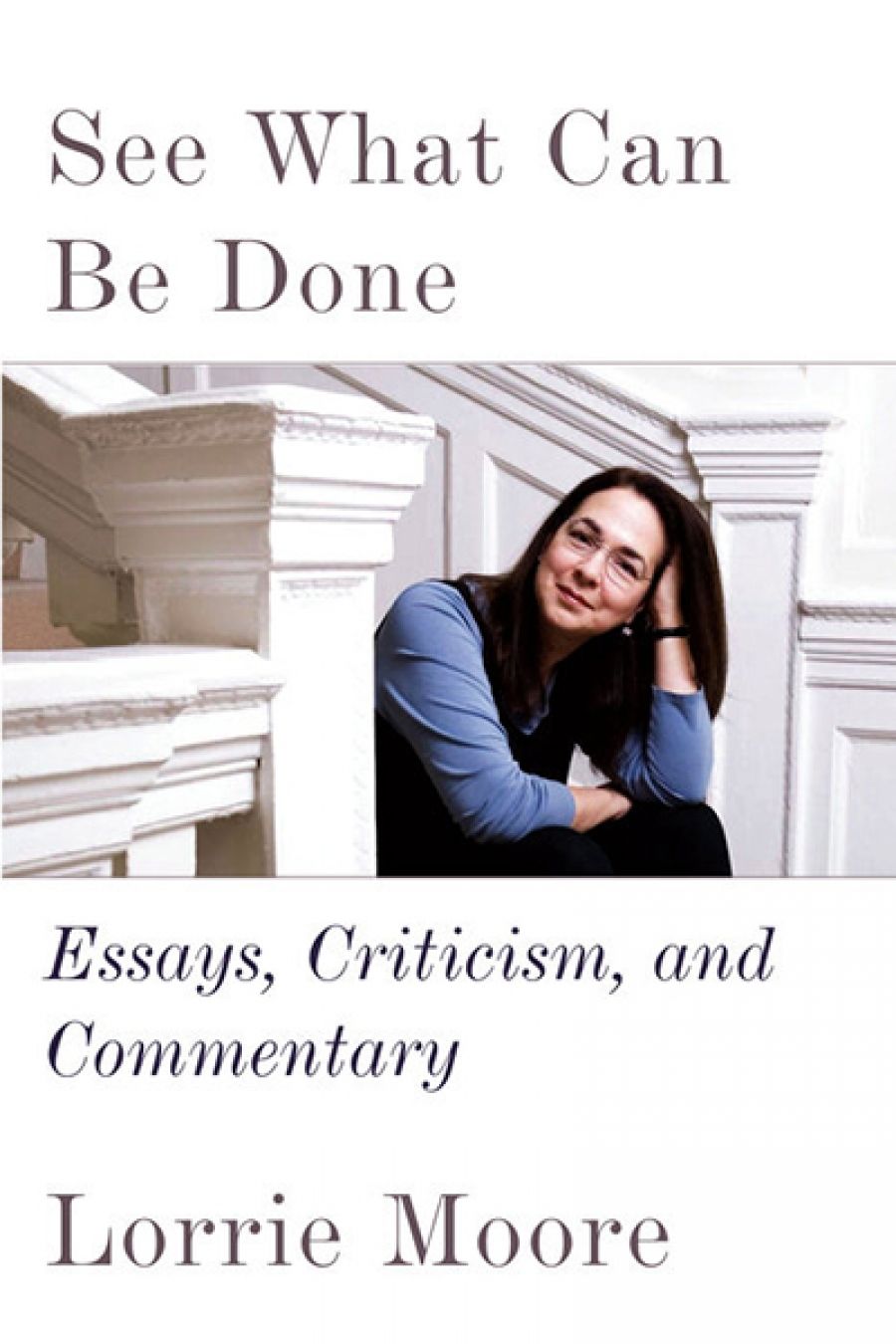
- Free Article: No
- Contents Category: Essay Collection
- Custom Article Title: Lucas Thompson reviews 'See What Can Be Done: Essays, criticism, and commentary' by Lorrie Moore
- Review Article: Yes
- Online Only: No
- Custom Highlight Text:
It saddens me to say it, but Lorrie Moore’s first collection of non-fiction is a serious disappointment. Having long admired her astonishing fiction, I came to this new book expecting to find obscure essays and little-known gems from across Moore’s long career ...
- Book 1 Title: See What Can Be Done
- Book 1 Subtitle: Essays, criticism, and commentary
- Book 1 Biblio: Faber & Faber, $39.95 pb, 432 pp, 9780571339921
Many of these reviews, it has to be said, are witty, erudite, and helpfully attuned to the kinds of details that only a professional writer would notice. Moore’s range is truly impressive, and the collection gives us a sense of her eclectic interests. These pieces range from Anaïs Nin to Marilyn Monroe, from Edna St. Vincent Millay to the finer points of Homeland and The Wire. In her brief introduction, she praises the late NYRB editor Robert Silvers for being ‘hiply catholic in his tastes and interests’ – a description that applies equally to her own.
And yet there’s something unsatisfying about many of these reviews, which seem increasingly anaemic as one progresses through the book. Too many of Moore’s assessments of novels, short story collections, and television series are taken up with lengthy plot summaries punctuated with droll asides, an approach that works well in context, but quickly tires across an anthology. Oddly enough, Moore also tends to steer away from strong judgements, or even judgements of any kind: one often has to wait until the end of a review to discover what she really thinks about a particular book or television series. Her occasional attempts at more trenchant forms of critique mostly fall flat: she prefers a breezy approach that skips lightly across the surface of texts, only rarely revealing what is at stake in her own aesthetic encounters.
In short, almost every element of this collection seems a pale imitation of what Moore is able to pull off in her fiction. The prose throughout is serviceable, rather than spectacular; the analysis sound rather than inspired; the tone vaguely companionable rather than truly intimate. The gags, too, are fewer and farther between than one might expect, though it has to be admitted that she does get in some of her trademark literary sass and snap from time to time. There is her description of Gertrude Stein, for instance, as ‘the literary love child of William James and Tweedledee’, and a memorable wisecrack on the orthography of ‘Crosby, Still, Nash & Young’ – ‘Ampersand and no oxford comma for Young’, she notes: ‘when he needs to get out of a band, he flees quickly’. Elsewhere, she impishly suggests that Edna St. Vincent Millay ‘owned, perhaps, too many evening gowns’ to be claimed as a feminist poet by subsequent generations, and wonders whether the appeal of Lena Dunham’s Girls arises from ‘the partially hand-held camera or the partially hand-held life’.
 Lorrie Moore (photograph by Zane Williams)At times, it’s difficult to tell whether she’s deliberately holding back, or if the format simply won’t allow for the expression of her full range of linguistic talent. Moore also isn’t particularly sharp on politics: her ‘Thoughts on Hillary’ from 2017 aren’t especially original or interesting, and she wisely chooses not to include two other pieces she wrote on Clinton in 2007 and 2008, which are even more dated. (She also admits to having voted multiple times for the ‘spoiler’ Green presidential candidate Ralph Nader, which I suspect will cause many readers to disregard her political opinions and analysis.)
Lorrie Moore (photograph by Zane Williams)At times, it’s difficult to tell whether she’s deliberately holding back, or if the format simply won’t allow for the expression of her full range of linguistic talent. Moore also isn’t particularly sharp on politics: her ‘Thoughts on Hillary’ from 2017 aren’t especially original or interesting, and she wisely chooses not to include two other pieces she wrote on Clinton in 2007 and 2008, which are even more dated. (She also admits to having voted multiple times for the ‘spoiler’ Green presidential candidate Ralph Nader, which I suspect will cause many readers to disregard her political opinions and analysis.)
While none of these pieces would have raised eyebrows or seemed out of place in their original settings, in this anthologised format they prompt one to wonder whether they really deserve collecting. There simply doesn’t seem to be enough variation, or insight, or originality to justify this kind of treatment. While Moore’s fame and literary prestige will guarantee that the book sells, who is this collection really for? Doubtless certain fans and completists will be happy to have these once-far-flung pieces corralled within a single volume, as will academics trying to piece together the interests and obsessions that have informed Moore’s ground-breaking fiction. But who else needs such a book?
Reading this collection, I had to keep reminding myself that Moore’s fiction is truly luminous. She has an almost unparalleled gift for capturing the casual wittiness, intimacies, and self-deceptions of everyday speech, and an effortless way of enfleshing characters and locations. Her 1998 collection Birds of America is surely one of the best American short story collections of the postwar period, and her three novels offer profoundly rich and complex pleasures. All of which makes See What Can Be Done even more disappointing. Revealingly, in the Acknowledgments section, Moore thanks ‘the tiny handful of people who thought this book was a good idea and encouraged it’. For my money, she should would have been far better off heeding those dissenting voices of the majority.


Comments powered by CComment